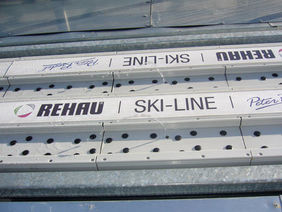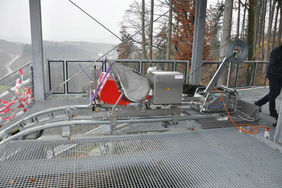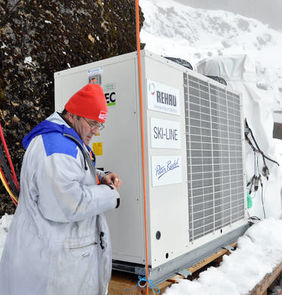RASCHAU/GARMISCH-PARTENKIRCHEN. During winter, they are the centre of attention. Everybody is talking about the ski jumps in Garmisch-Partenkirchen or Trondheim, Chaux-Neuve or Zao: when the world cup series of the International Ski Federation is stopping at these ski jumps. And a few days later, these competitions are history, the winners were selected, the results were analysed – let’s move to the next location.
An so, many people think that the most beautiful and high-profile ski jumps of the world are only spruced up especially for these one or two championships only to be mothballed afterwards until the next tournament, for example. Along the lines of: out of sight, out of mind.
Reality, however, contradicts in an impressive manner. A few days after the New Year’s competition in Garmisch-Partenkirchen, a competition for the German cup was held at the same location – during which the Peter Riedel track performed excellently despite pouring rain – the FIS Cup final was organised later. And international student competitions or national tournaments also take place during summer. There is also the offer of training to different organisations and nations. To stick with the example of Garmisch-Partenkirchen: the students from the Austrian Stams, a cadre training unit of the Austrian Ski Federation, show up there frequently. Moreover, more and more national teams come to Bavaria, says Michael Maurer, President of the SC Partenkirchen: “On the one hand, Central European athletes save the trip to Scandinavia, and on the other hand, they are able to jump on ice as early as autumn. And at the same time, training on the Olympic Hill is the best preparation for the New Year’s competition.”
In any case, it is clear that a modern ski jump is – put crudely – like a car. Refitting has to be carried out twice per year, from winter tyres to summer tyres, from winter track to summer track, and vice versa. Furthermore, after the snow has thawed, the snow retaining nets on the mats have to be removed, and re-assembled before the first snow in late autumn.
Therefore, a ski jump, whether in Garmisch-Partenkirchen or in Hinzenbach, in Courchevel or Chaykovsky, is an “all-year project” – after all, the construction cost a nice little sum of money, which is why the sports facilities have to (or should) justify and pay off.
Meanwhile, all-year operation would be impossible without the maintenance of the inrun system “Double Track”, and Michael Maurer is glad that the community Garmisch-Partenkirchen has concluded a maintenance contract with the company Riedel. This contract is all the more important because the existing data systems make the tour ski jump – together with a few other systems worldwide – particularly sensitive. For example, various sensors and precision elements have to be inspected, and the pressure measuring plates have to be re-adjusted – just as the tyre pressure in cars is being adjusted.
Maurer again: “When Wolfgang Riedel visits us, he converts the track from winter to summer or vice versa. He inspects the lines, checks if there is enough coolant in the tanks. In short, he does everything to give us piece of mind and a clean conscience. The success of our system is also based on this good cooperation, and we no longer have to worry about the inrun – the next New Year’s competition can come!” And for that, company owner Peter Riedel will also be present at the track – because at Riedel, nothing is left to chance.
Ski jumping systems are the centre of attention for twelve months of the year after all, at least for the operators!








